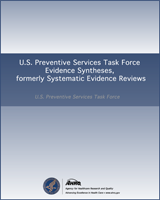NCBI Bookshelf. A service of the National Library of Medicine, National Institutes of Health.
Excerpt
We undertook this systematic review to assist the U.S. Preventive Services Task Force (USPSTF) in updating its 2003 recommendation on cervical cancer screening. During the planning phase of this evidence review on cervical cancer screening, the Agency for Healthcare Research and Quality (AHRQ) decided to fund a separate modeling study to be conducted simultaneously. The USPSTF determined that the scope for both the systematic review and the modeling study would focus on important clinical questions that could inform effective use of screening in practice. This systematic review focuses on when to begin screening and on updating test accuracy and harms data on liquid-based cytology (LBC) and human papillomavirus (HPV) testing, either alone or in combination with cytology. The modeling study focuses on the effectiveness of strategies that use different ages at which to begin screening and different screening intervals.1 These two reports are intended to provide the USPSTF with complementary information to update its recommendation on cervical cancer screening.
Contents
- October 2011 Update
- Structured Abstract
- 1. Introduction
- 2. Methods
- 3. Results
- Key Question 1 When Should Cervical Cancer Screening Begin, and Does This Vary By Screening Technology or By Age, Sexual History, or Other Patient Characteristics?
- Key Question 2 To What Extent Does Liquid-Based Cytology Improve Sensitivity, Specificity, and Diagnostic Yield and Reduce Indeterminate Results and Inadequate Samples Compared to Conventional Cervical Cytology?
- Key Question 3 What Are the Benefits of Using HPV Testing as a Screening Test, Either Alone or in Combination With Cytology, Compared With Not Testing for HPV?
- Key Question 4 What Are the Harms of Liquid-Based Cytology?
- Key Question 5 What Are the Harms of Using HPV Testing as a Screening Test, Either Alone or in Combination With Cytology?
- 4. Discussion
- Summary of Review Findings
- Initiation of Cervical Cancer Screening
- Liquid-Based Cytology Compared to Conventional Cytology for Primary Cervical Cancer Screening
- HPV-Enhanced Primary Cervical Cancer Screening
- Age at Which to Stop Cervical Cancer Screening
- Limitations
- Emerging Issues/Next Steps
- Future Research
- Conclusions
- References
- Appendixes
- Appendix A Terminology and Abbreviations
- Appendix B Detailed Methods
- Appendix C Evidence Tables
- Appendix D Excluded Studies
- Appendix E Screening Benefit Considerations Illustrated by NTCC Phase II Trial
- Appendix F Ongoing and Pending Trials
- Appendix G Recommendations of Other Groups
- Appendix H Cervical Cancer and HPV: Prevalence, Incidence and Mortality Rates
Prepared for: Agency for Healthcare Research and Quality, U.S. Department of Health and Human Services1, Contract No. HHS-290-2007-10057-I, Task Order No. 3, Prepared by: Oregon Evidence-based Practice Center, Portland, Oregon
Suggested citation:
Vesco KK, Whitlock EP, Eder M, Lin J, Burda BU, Senger CA, Holmes RS, Fu R, Zuber S. Screening for Cervical Cancer: A Systematic Evidence Review for the U.S. Preventive Services Task Force. Evidence Synthesis No. 86. AHRQ Publication No. 11-05156-EF-1. Rockville, MD: Agency for Healthcare Research and Quality; May 2011.
This report is based on research conducted by the Oregon Evidence-based Practice Center (EPC) under contract to the Agency for Healthcare Research and Quality (AHRQ), Rockville, MD (Contract No. HHS-290-2007-10057-I). The findings and conclusions in this document are those of the author(s), who are responsible for its content, and do not necessarily represent the views of AHRQ. No statement in this report should be construed as an official position of AHRQ or of the U.S. Department of Health and Human Services.
The information in this report is intended to help clinicians, employers, policymakers, and others make informed decisions about the provision of health care services. This report is intended as a reference and not as a substitute for clinical judgment.
This report may be used, in whole or in part, as the basis for the development of clinical practice guidelines and other quality enhancement tools, or as a basis for reimbursement and coverage policies. AHRQ or U.S. Department of Health and Human Services endorsement of such derivative products may not be stated or implied.
None of the investigators has any affiliation or financial involvement that conflicts with the material presented in this report.
- 1
540 Gaither Road, Rockville, MD 20850; www
.ahrq.gov
